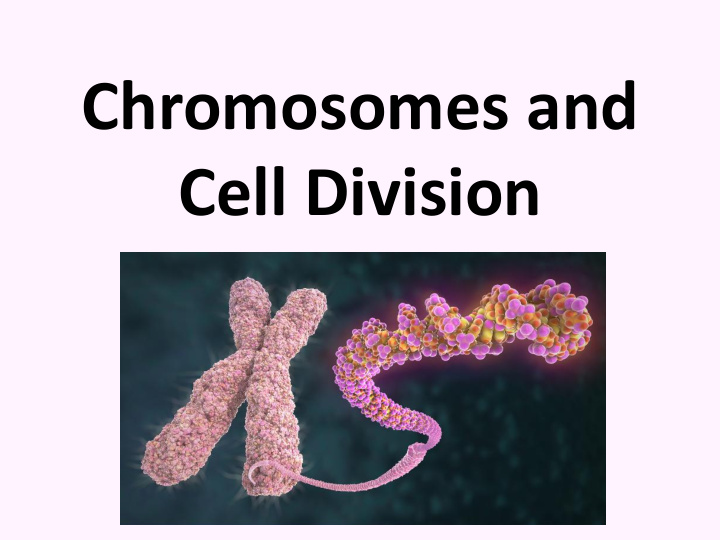



Chromosomes and Cell Division
Chromatin and Chromosomes
Chromosome Terms • chromatid • centromere • p arm • q arm • telomere • kinetochore
Chromosome Structure
Telomeres
Kinetochores
Role of Kinetochores in Cell Division
Circular versus Linear Chromosomes
Prokaryotic Chromosome Replication • Chromosome (DNA) replication begins at a single site called the origin of replication
Eukaryotic Chromosome Replication • Chromosome (DNA) replication begins at multiple points along the DNA molecule
Cell Division 1. Binary Fission 2. Mitosis 3. Meiosis
Binary Fission • Cell division in prokaryotic cells (bacteria) • Asexual reproduction of unicellular eukaryotes
Complete the t-chart to explain three differences between mitosis and meiosis:
Cell Cycle and Mitosis
Cell Cycle and Mitosis • Growth, repair, replacement of dead or damaged cells, development, and asexual reproduction • Occurs in the formation of somatic (body) cells • Resulting daughter cells are genetically identical
Cell Cycle
Cell Cycle (Watch this 6 minute video to review the Cell Cycle) • Complex set of stages that is highly regulated with checkpoints (determine the ultimate fate of the cell) • Consists of interphase (G 1 , S, G 2 ), mitosis and cytokinesis • Results in two genetically identical daughter cells
G 0 • Exit point from the cell cycle • Resting or non-dividing stage, cell has reached final stage of specialization Examples of cells: • Neurons or cardiac muscle cells – permanent ( terminal differentiation ) • Liver and kidney – semi-permanent • Epithelial cells (lining) - rarely
Cell Cycle Checkpoints
Regulatory Molecules (Watch this 3 minute video to learn about regulation of the cell cycle) • Cell cycle is regulated by cyclins and cyclin- dependent kinases (CDKs) which pace the sequential events of the cell cycle 1. cyclins – proteins that activate kinases 2. kinases (CDKs) – enzymes that activate or deactivate other proteins by phosphorylation • Form CDK-cyclin complexes to stimulate the cell cycle
Fluctuations in Cyclin Levels
MPF (Mitosis Promoting Factor) • Example of a cyclin-CDK complex • Acts at the G2 checkpoint to trigger the events of the cell cycle ( internal cellular cue)
PDGF (Platelet-Derived Growth Factor) • Example of a growth factor that affects cell division primarily in blood vessels • Protein released by platelets that stimulate fibroblasts to divide ( external cellular cue) • PDGF binds to receptors on fibroblasts
Other Regulatory Processes
Tumor Suppressor Genes (Watch this 2 minute video about tumor suppressor genes) • Genes that inhibit the cell cycle or promote apoptosis (programmed cell death) Examples include: • p53 and Rb – act at the G1 checkpoint • ATM and BRCA1 – act at the S checkpoint • p53 – acts at the G2 checkpoint
Healthy versus Cancer Cell Division
p53 Tumor Suppressor Gene • Acts at the G 1 and G 2 checkpoints • Determines whether damaged DNA will be repaired during cell division ( arrest cell division ) OR • Damaged DNA cannot be repaired or is too excessive – triggers cell death ( apoptosis ) • “Guardian of the Genome”
p53 Tumor Suppressor Gene
S Checkpoint: ATM and BRCA1 • Both act to inhibit the cell cycle at the S checkpoint • If DNA is broken during replication, ATM protein is activated, halts the cell cycle • ATM then activates other proteins such as BRCA1 to mediate DNA repair or trigger apoptosis
M Checkpoint: Anaphase-Promoting Complex/Cyclosome (APC/C) and Mitotic Arrest Deficient (MAD) • APC/C stimulates the destruction of proteins at the centromere to allow the sister chromatids to separate ( anaphase ) • MAD acts to inhibit APC/C if chromosomes are not properly attached to the spindle Consequences?
Errors at the M Checkpoint
Cell Cycle Checkpoints • Watch this 6 minute video to review cell cycle regulation
Recommend
More recommend